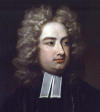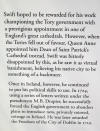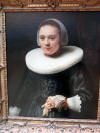





...his longtime partner, Stella, see note










Ireland '23 - Day 2 - Dublin destinations
return to Ireland 23 index
return to mdimage index
On Saturday morning, having slept well, I woke at 5 am. The tiny room had no tea/coffee kit, but twice the front desk guy made went into the bar and made me an Americano, and I enjoyed looking at maps of Dublin, downstairs.
It was unusual to be up so early, in a still-sleeping City.
At 7 am, the hotel served a terrific breakfast array, well-attended. Outside, it remained dark until 8 am.
On a cold & windy morning, I walked north for 20 minutes, to Saint Patrick's Cathedral, where I had a quiet self-guided tour about 10 am.
The original church was built in 1191, and in 1254, St. Pat's came about via renovation & expansion, modernized to an early English Gothic style.
This is a Church of Ireland Cathedral, unified with the (Anglican) Church of England, so Protestants & Catholics were not welcome.
Jonathan Swift (1667-1745) may be best known as the Irish author of Gulliver's Travels, but he was also an Anglican Minister, with a Divinity Degree from Oxford. In 1707, when he was 40, English Queen Anne appointed Swift as Dean of St. Patrick's in Dublin (he was English by birth) and he held that position for 32 years.
Dean Swift became known locally for kindness & service to the poor, leaving his entire legacy of 12,000 pounds to help fund a mental institution.
note - the story about Stella can be found on the Bibliography page.
Dean Swift was property manager, director of church services, and the HR Dept. At a time when 20 pounds a year was a decent salary, he oversaw an annual budget of 10,000 pounds. Over the years he demonstrated competent managerial abilities, reporting directly to the Archbishop of Ireland, who like Swift lived near the Cathedral.
Dean Swift the Anglican Minister held one Sunday service a month and gave a sermon, supposedly well-attended.
Jonathan Swift the author was a creative & complex man, both outspoken & secretive. Gulliver's Travels, like most of his major works, was published using a pseudonym. Readers in England & Ireland recognized his style and knew he did this to avoid accusations (by Parliament) of disloyalty to the Crown.
Swift's anti-Parliament stance (in his widely published & read Treatises) over decades made him a hero to the Irish people. During his last 20 years, his birthday was a city-wide celebration, with time off from work, evening bonfires, and food & ale for all. (Swift info - see bibliography page - link is above).
River Liffey seemed attractive at first, but on each side there's a three-lane (one way) thoroughfare, and cars & tour buses are constant, as are intense diesel fumes. I walked along the river for 4 blocks & then headed southeast.
 |
looking east |
 |
two river travelers |
 |
National Gallery - this took some time to find, but it was good to be out walking around the City. The Fodors guide says a person could walk from one end of Dublin to the other, in about an hour (probably within City limits).
I enjoyed spending time at the art museum, and it was pleasantly uncrowded. There was a good display of Irish painters downstairs and upstairs were European standards, in spacious & elegant rooms.
 |
see note |
 |
 |
 |
Liffey Swim, see note |
 |
European paintings |
 |
Vermeer, 1670 | ||
 |
Rembrandt, 1632 |
 |
the undisputed master of the face & eyes (note tiny pearl ear rings). |
note - Ireland's best known painter, Jack Butler Yates, was the younger brother of poet William Butler Yates, who won the 1923 Nobel Prize for Literature (more on him near the end of the trip).
One year later, Jack Yates submitted the above painting (Liffey Swim) and won an Olympic Silver Medal in Paris in 1924, in the Arts & Culture category.
Jack's artistic style changed a few times and the first room in the Irish painters Wing was full of his works. I found his later works too dark & abstract.
After two hours I had seen most of the modest collection, and had read a lot of the display info, and felt tired. The Museum has an attractive cafe, with a glass ceiling maybe 100 ft. high, where two buildings (one old and one new) intersect at right angles. I felt refreshed by the brightly-lit architectural space, and, by a scone with butter & jam plus an Americano.
Later while browsing in the museum gift shop, I found a book written by a retired Dublin (Criminal) Superior Court Judge, Gillian Hussey. It turned out to about Dublin social realities & kept me company for a week.
next page - Dublin again
return to Ireland 23 index
return to mdimage index
On Saturday evening I dined again at Iveagh Garden Hotel, and then read, or wrote in the journal for a few hours. My wife and I realized we overlapped only for a short time, morning & night, and we kept up to date with calls or texts.
Postscript - On my 2nd night there I tried to stay up late (like 11 pm?). Around 9 pm I started hearing irregular shouts coming from the neighborhood. I walked upstairs and asked the front desk person if there was a concert going on nearby, and he said "those are local pubs, watching Rugby, and yelling when the home team scores".
He added "if you go outside you can hear every pub in Dublin yelling at the same time". I did go outside, long enough to discover that it was frightfully cold, and Harcourt was deserted.
What he didn't tell me was that Ireland was (just then) playing New Zealand in a World Cup Quarter-final Rugby match.
I'm no rugby fan, but hey, WC status = meaningful, no ? As I learned later, it was a close match, with NZ prevailing in the end. The game was not played in Ireland, and, it was the first time Ireland had advanced so far into WC playoffs.
I fell asleep at 10:30 pm and was woken up about 1:30 am, by the sound of some angry people outside, yelling or banging on the vertical metal pipes that delineate the bike lanes.
A small & disorganized crowd was meandering south, no doubt coming from Temple Bar, to the north, where the pubs must have closed. It was the sound of the losing team's angst....
For a few moments it was bizarre, but, a portable room fan was going (for white noise, like at home) and I closed the vent window, and everything was fine.
Go to next page - Dublin again
*